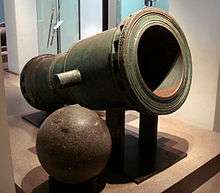Faule Grete
| Faule Grete | |
|---|---|
|
Modern, fanciful illustration of the Faule Grete in action at the siege of Friesack in 1414. Contrary to the ordnance depicted, the Faule Grete was not assembled from wrought-iron bars, but a cast cannon. | |
| Type | Cannon |
| Place of origin | Marienburg, Monastic state of the Teutonic Knights |
| Service history | |
| Used by | Margrave Frederick I of Brandenburg |
| Production history | |
| Produced | 1409 |
| Specifications | |
| Weight | 4.6 t |
| Length | 250 cm |
| Barrel length | 150 cm |
|
| |
| Shell weight | 170 kg |
| Caliber | 50 cm (ball diameter) |

The Faule Grete (German for Lazy Grete, alluding to the lack of mobility and slow rate of fire of such super-sized cannon) was a medieval supergun of the Teutonic Order. The bronze bombard was cast in 1409 in the cannon foundry of the Marienburg by the gunfounder Heynrich Dumechen.[2] According to the account books of the order, the construction costs amounted to 278.5 Mark, a sum equivalent to ca. 1160 oxen.[3]
Borrowed by Margrave Frederick I of Brandenburg in 1413, the cannon was instrumental in breaking the opposition of the domestic knighthood within three weeks, allowing Fredrick to lay the foundation for the rise of his Hohenzollern dynasty which later came to rule Prussia and the Deutsches Reich.[4]
Besides the Faule Grete, a number of 15th-century European superguns are known to have been employed primarily in siege warfare, including the wrought-iron Pumhart von Steyr, Dulle Griet and Mons Meg as well as the cast-bronze Grose Bochse (also made by the Teutonic Knights) and Faule Mette.
Footnotes
- ↑ Schmidtchen 1977, p. 220
- ↑ Schmidtchen 1977, p. 218
- ↑ Schmidtchen 1977, p. 219
- ↑ Schmidtchen 1977, pp. 220f.
References
- Schmidtchen, Volker (1977), "Riesengeschütze des 15. Jahrhunderts. Technische Höchstleistungen ihrer Zeit", Technikgeschichte, 44 (3): 213–237 (217–221)
See also
External links
![]() Media related to Faule Grete at Wikimedia Commons
Media related to Faule Grete at Wikimedia Commons
